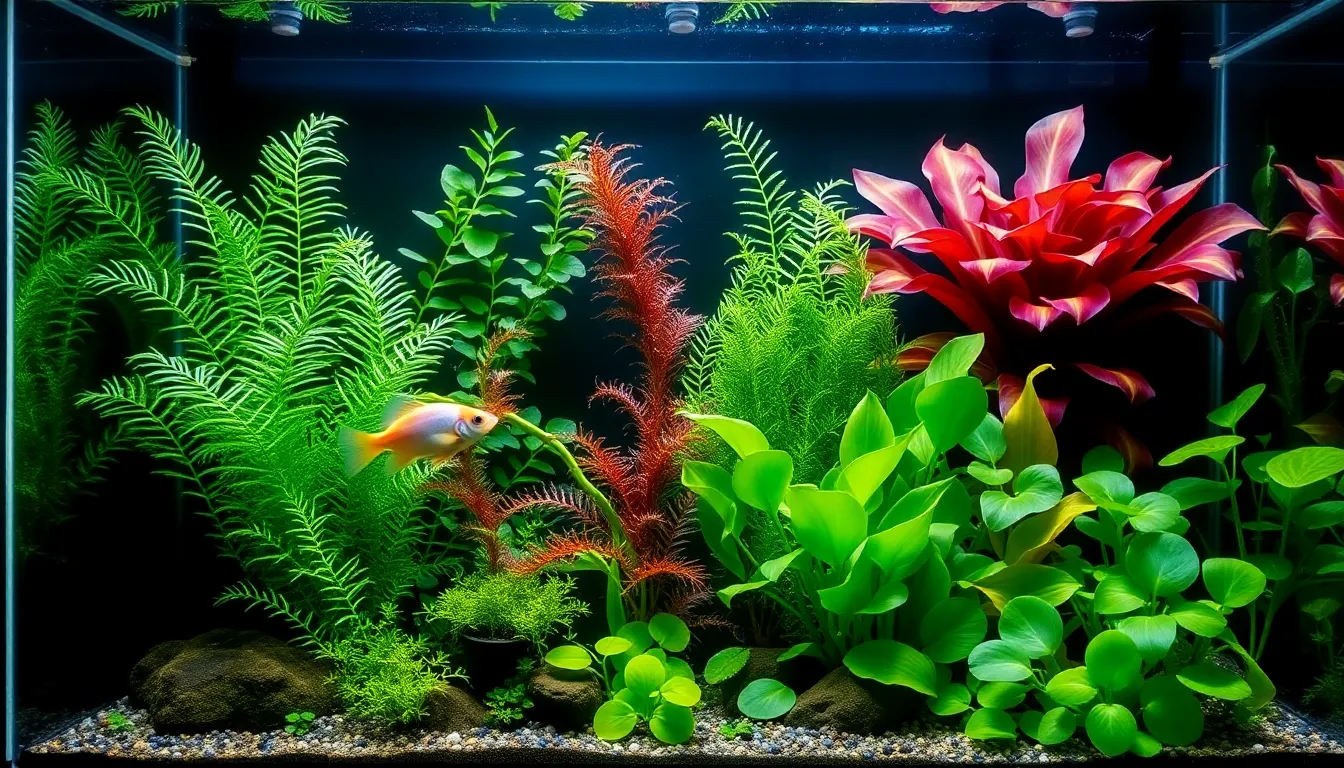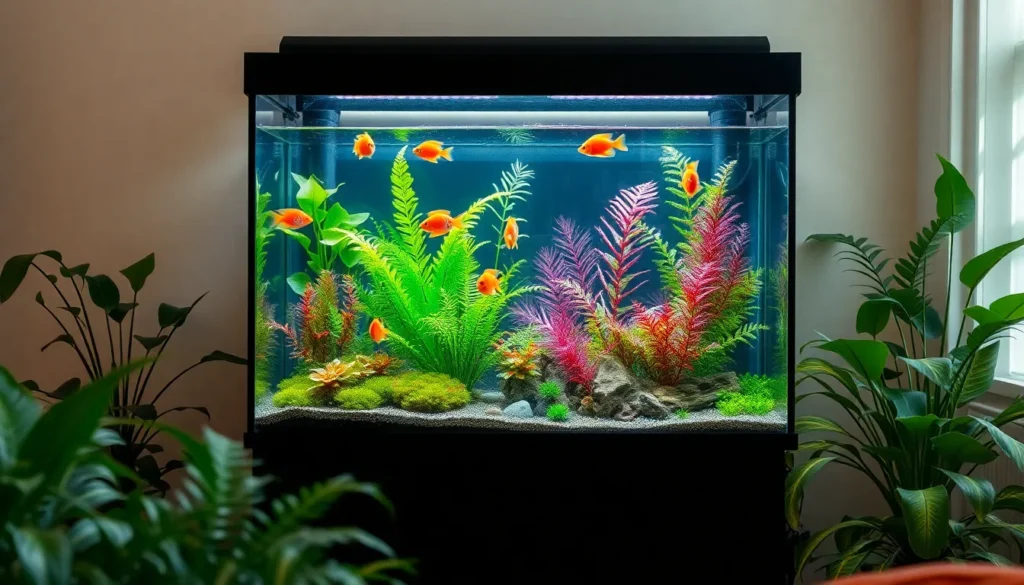Table of Contents
ToggleImagine transforming your living space into a vibrant oasis where lush greenery meets the soothing rhythm of water. Indoor house plants in a fish tank aren’t just a quirky trend; they’re a brilliant way to combine nature’s beauty with a splash of aquatic charm. Who wouldn’t want to impress friends with a mesmerizing underwater garden that doubles as a home for happy fish?
The best part? These aquatic plant arrangements are not only visually stunning but also create a healthier environment for both plants and fish. It’s like giving your fish a spa day while treating yourself to a mini jungle adventure right in your living room. Dive into the world of indoor house plants in fish tanks and discover how to create a stunning centerpiece that’s sure to make waves in your home decor.
Benefits of Using Indoor House Plants in Fish Tank
Combining indoor house plants with fish tanks offers multiple advantages, enhancing both the environment and aesthetics. These arrangements not only benefit aquatic life but also improve interior design.
Improved Water Quality
Indoor house plants play a significant role in maintaining water quality within fish tanks. Plants absorb harmful toxins like ammonia and nitrates, resulting in cleaner, healthier water. These natural filtration systems reduce stress on fish and promote their well-being. Healthier fish exhibit vibrant colors and active behavior. Regular maintenance becomes simpler, encouraging an easier care routine. Overall, integrating plants leads to a balanced ecosystem, enhancing the aquatic environment.
Aesthetic Appeal
The visual impact of indoor house plants in fish tanks cannot be overstated. Lush greenery contrasts beautifully with colorful fish, creating a vibrant focal point in any room. Various plant species contribute diverse shapes and textures, enriching the overall design. Aquatic plants can soften the hard edges of a tank, improving the natural look. Homeowners create tranquil, inviting spaces that promote relaxation and enjoyment. This harmonious blend of flora and fauna elevates interior decor, drawing admiration from guests.
Best Indoor House Plants for Fish Tanks

Indoor house plants thrive in fish tanks, enhancing both aesthetics and ecosystem health. Consider integrating these plants to create a beautiful, balanced environment.
Low Light Plants
Low light plants adapt well to fish tank settings. Anubias, for instance, grows slowly and tolerates low light conditions, making it ideal for dimly lit tanks. Java fern also excels in shade, offering attractive foliage and a natural habitat for fish. Moreover, snake plant provides air-purifying benefits while thriving under minimal light. These plants require minimal maintenance, allowing for a more hands-off approach to aquarium care.
Floating Plants
Floating plants add unique visual appeal and offer functional benefits in fish tanks. Water lettuce creates a dramatic floating surface that helps reduce algae growth by blocking excess light. Duckweed pairs well with various fish species and improves water quality through nutrient absorption. Additionally, hornwort grows rapidly and provides shelter for fish while also stabilizing water conditions. Incorporating floating plants enhances both beauty and biological balance within the aquarium ecosystem.
Maintenance Tips for Plants in Fish Tanks
Maintaining plants in fish tanks contributes to a healthy ecosystem. Implementing practical tips ensures better growth and vitality for both flora and fish.
Choosing the Right Substrate
Selecting the appropriate substrate promotes plant health. Aquatic plants thrive best in nutrient-rich substrates like aquarium soil or clay pellets. These materials provide essential minerals while improving water retention. Layering gravel on top can prevent substrate disturbance and enhance aesthetics. Careful consideration of substrate depth also matters; aim for 2 to 3 inches to accommodate root systems. Regularly monitoring substrate conditions ensures continued support for plants.
Regular Pruning and Care
Pruning maintains the health and appearance of plants in fish tanks. Regularly trimming dead or yellowing leaves encourages new growth and prevents decay, which could affect water quality. Inspecting plants weekly assists in removing unwanted growth and ensuring they don’t overcrowd the tank. Adjusting lighting and fertilization as necessary supports plant development. Keeping an eye on water conditions will benefit both plants and fish, as clean water enhances overall health.
Common Challenges and Solutions
Managing indoor house plants in fish tanks presents specific challenges. Addressing these common issues can enhance both plant and fish health.
Algae Growth
Algae often thrives in aquariums with excess nutrients and light. Controlling algae growth requires balanced lighting; aim for 8 to 10 hours of light daily. Regular water changes help remove excess nutrients, reducing algae proliferation. Including floating plants can shade the tank’s surface, limiting light penetration and hindering algae growth. Utilizing aquarium-safe algae eaters, such as certain fish or snails, offers a natural solution to keep algae levels in check.
Plant Compatibility with Fish
Selecting compatible plants and fish is crucial for a harmonious ecosystem. Choosing plants that are resilient and non-toxic ensures fish safety. Popular choices include Anubias and Java fern, which also provide shelter. Be mindful of fish behavior; some species may nibble on plants. Striking a balance between plant foliage and fish activity promotes a thriving environment for both. Keeping plants healthy supports fish welfare by improving water conditions.
Integrating indoor house plants into fish tanks offers a unique way to enhance the beauty and health of both flora and fauna. This creative approach not only beautifies living spaces but also promotes a balanced ecosystem that benefits fish and plants alike.
By choosing the right plants and maintaining proper care, individuals can create a thriving aquatic environment. The combination of vibrant greenery and colorful fish results in a stunning focal point that invites relaxation and enjoyment.
With the right knowledge and techniques, anyone can successfully embark on this rewarding journey, transforming their home into a serene nature-inspired oasis.







